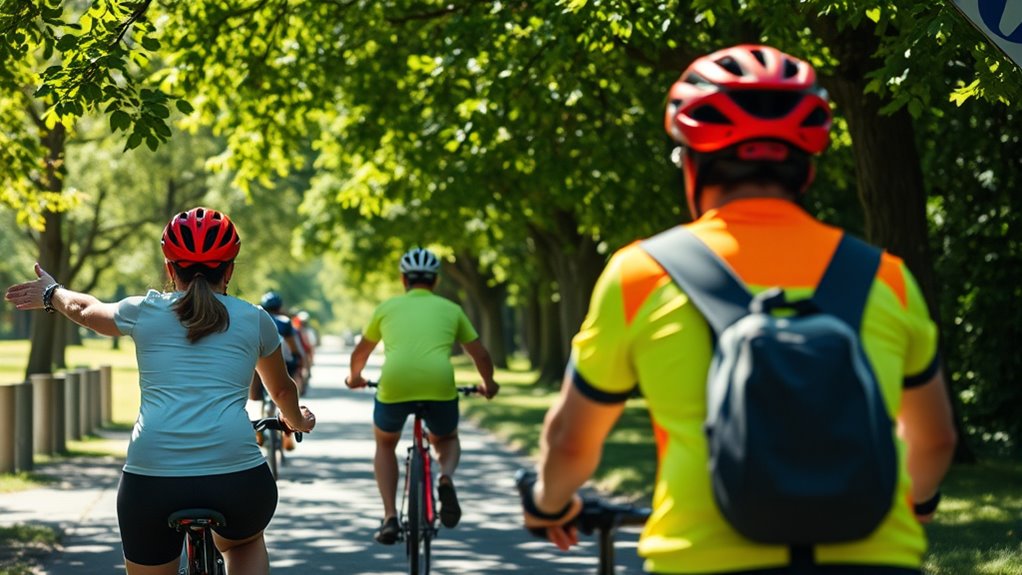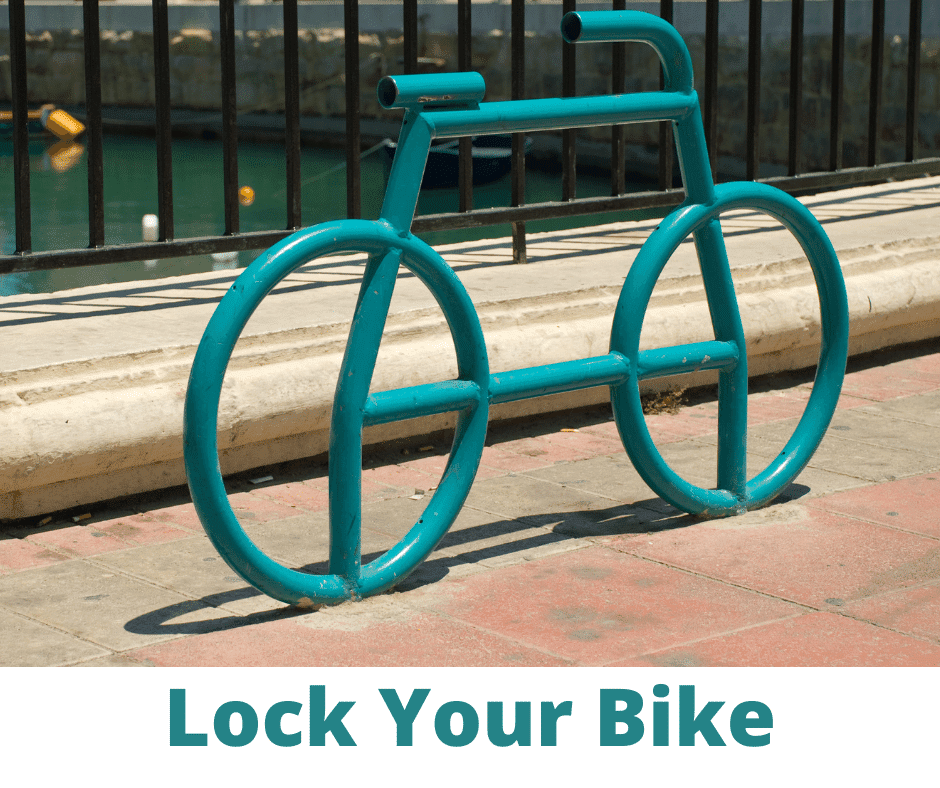Cycling etiquette is essential for your safety and the well-being of everyone on the road or trail. Follow traffic laws like signaling turns and staying aware of your surroundings. Whether you’re riding solo or in a group, communicate clearly and maintain appropriate spacing to avoid accidents. Always respect other road users by adhering to established rules. Want to enhance your cycling experience further? There’s more useful information that can help you become a better cyclist.
Key Takeaways
- Always follow local traffic laws and ride with the flow of traffic to ensure safety for all road users.
- Use hand signals for turns and communicate hazards vocally to enhance awareness among cyclists and motorists.
- Maintain a safe distance from other cyclists, keeping at least three feet between bikes to avoid accidents.
- Wear bright or reflective clothing and use lights to increase visibility, especially during low-light conditions or night riding.
- Be mindful of your surroundings and avoid distractions, like earbuds, to maintain focus while cycling on the road or trail.
Importance of Cycling Etiquette

Cycling etiquette is essential, not just for your safety but for the well-being of everyone on the road. By following cycling etiquette, you reduce the risk of accidents and conflicts with fellow cyclists, pedestrians, and motorists.
Effective communication, like signaling your turns and announcing your intentions, makes it easier for others to anticipate your movements, ensuring it’s safe to pass. When you adhere to local traffic laws and path rules, you maintain your rights while being considerate of others.
This fosters respect and cooperation within the cycling community, creating camaraderie among riders. Practicing good cycling etiquette, such as yielding to pedestrians and keeping a safe distance, promotes a positive image of cyclists and enhances everyone’s riding experience. Additionally, being aware of traffic laws specific to cycling can further ensure safety and compliance on the road.
Solo Road Riding Guidelines

When you’re out riding solo, it’s essential to follow local traffic laws just like any motorist would.
Always signal your intentions clearly to keep everyone safe on the road.
Plus, staying aware of your surroundings can help you avoid accidents and make your ride more enjoyable. Regular maintenance of your equipment, such as checking tire pressure, can also enhance your safety and performance on the road.
Follow Local Rules
Understanding and following local rules is essential for safe solo road riding. These regulations help you navigate the roads confidently while keeping yourself and others safe.
Remember to:
- Obey stop signs and traffic signals, just like motor vehicles.
- Use hand signals for turns and stops to communicate with fellow riders.
- Ride straight and predictably to avoid sudden maneuvers.
- Avoid sidewalks unless explicitly allowed, as they can endanger pedestrians.
- Stay aware of your surroundings by skipping earbuds, ensuring you hear approaching vehicles. Additionally, practicing road safety can significantly reduce the likelihood of accidents while cycling.
Signal Your Intentions
Effective communication is essential for safe solo road riding, and signaling your intentions plays a significant role in this process. Always use hand signals to indicate turns and stops, informing other road users of what you plan to do.
Keep one hand on the handlebars when signaling to maintain control of your bike. Additionally, make eye contact with motorists and pedestrians whenever possible; this guarantees they recognize your presence.
When approaching other cyclists or pedestrians, use verbal cues like “slowing” or “stopping” to give them adequate time to react. Be consistent in your signaling to foster predictability, helping others anticipate your actions and reducing the risk of accidents. Remember, safe riding starts with clear communication, just as mastering the art of bug out bags requires essential planning and preparation!
Safe riding starts with clear communication!
Maintain Situational Awareness
To ride safely, you must maintain situational awareness while on the road. Stay alert and avoid distractions like earbuds.
Here’s how to enhance your focus and safety:
- Continuously scan your environment; look ahead, behind, and to your sides.
- Keep to the right to allow faster cyclists to pass safely.
- Use hand signals to communicate your intentions clearly.
- Maintain a safe distance from parked vehicles to prevent dooring accidents.
- Acknowledge fellow cyclists and road users with a nod or wave.
- Consider carrying a first aid kit to handle any minor injuries while on the road.
Group Riding Best Practices
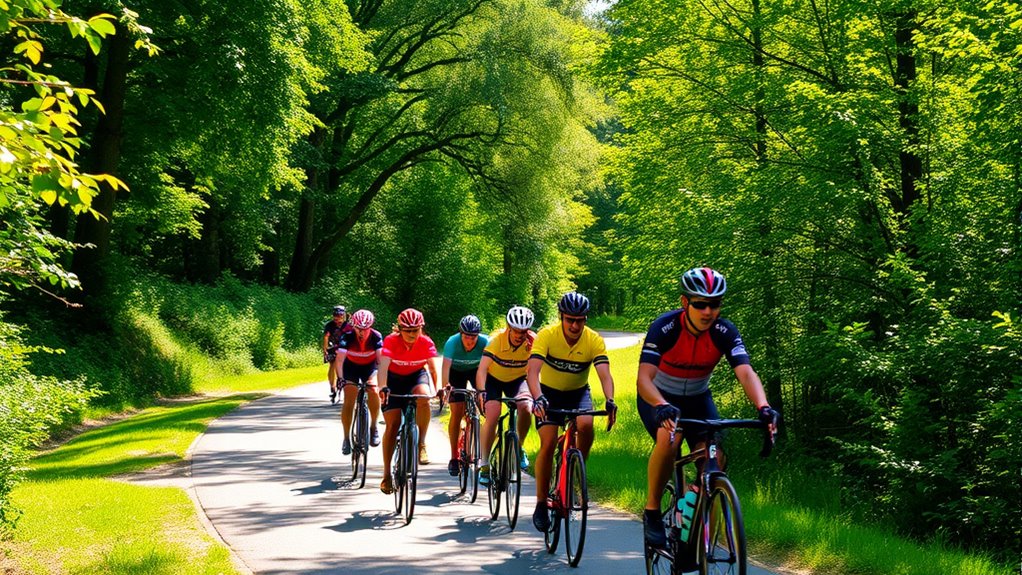
When you ride in a group, effective communication and signaling are essential for safety and cohesion. Positioning yourself correctly and maintaining appropriate spacing helps prevent accidents and keeps everyone comfortable. Additionally, understanding the importance of group riding dynamics can enhance your experience and ensure that all participants remain safe and engaged.
Communication and Signaling
Communication and signaling play an essential role in group riding, as they help guarantee everyone’s safety and enjoyment.
As a rider, you need to be clear and consistent in your signals to keep the group cohesive. Here are some best practices to follow:
- Use hand signals for turns and stops.
- Vocalize hazards like potholes or debris.
- Clearly announce changes in pace with phrases like “slowing” or “speeding up.”
- Maintain predictable movements to ascertain safety.
- Announce when passing another rider with “on your left.”
- Incorporating safety gear is crucial to enhance protection while riding in groups.
Positioning and Spacing
Riding in a group requires not just effective communication but also proper positioning and spacing to guarantee everyone’s safety and comfort.
Maintain a consistent line and avoid overlapping wheels to prevent crashes. Position your bike in a staggered formation, slightly offset from the rider in front, which helps with visibility and spacing. Always keep at least three feet between bikes to allow for sudden stops and reduce collision risks.
Use clear hand signals and verbal cues when changing positions or speeds, so everyone knows your intentions.
Finally, steer clear of half-wheeling, as it can create tension and disrupt the flow of group riding, making it uncomfortable for others. Additionally, embracing emotional growth during challenging riding experiences can enhance your overall enjoyment and camaraderie.
Prioritize these practices to enhance your group experience.
Group Dynamics and Support
While group dynamics play a crucial role in cycling, effective communication remains key to ensuring a smooth and enjoyable ride for everyone involved.
When you’re part of a group of riders, remember these best practices:
- Always signal turns and announce obstacles.
- Respect everyone’s skill level and pace.
- Offer positive reinforcement to encourage camaraderie.
- Collaborate on mechanical issues to minimize disruptions.
- Share ride plans beforehand for alignment.
It’s a good idea to foster a supportive atmosphere while riding in a group.
By doing so, you enhance not just your experience but everyone’s. Incorporating educational toys into playtime can similarly foster collaboration and skill development among young children.
With clear communication and mutual support, you’ll create lasting memories and stronger connections among fellow cyclists.
Communication in Group Rides
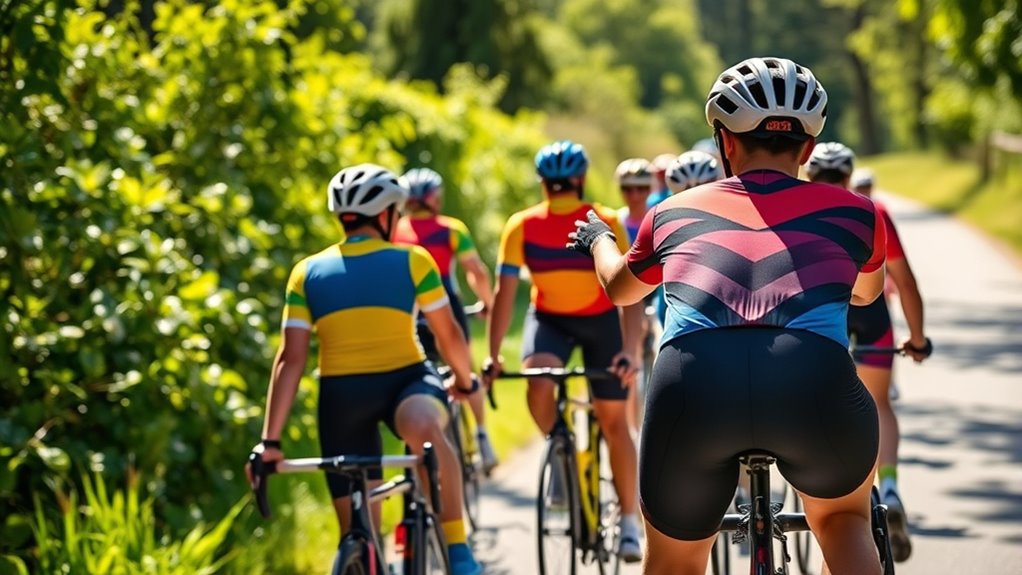
Effective communication is essential in group rides, as it helps guarantee everyone stays safe and informed. Use hand and verbal signals to clearly indicate turns and stops. Announce obstacles vocally to keep all riders aware and able to react. Maintain predictable movements on your path to avoid confusion. Additionally, ensure that group members are aware of the importance of well-draining soil for maintaining their bike’s components, as clean and dry conditions can enhance performance.
| Action | Signal Type | Purpose |
|---|---|---|
| Turn Left | Left hand signal | Indicate direction change |
| Stop | Hand up | Alert group to slow down |
| Obstacle Ahead | Vocal announcement | Warn others of potential hazards |
| Increase Pace | Shout “Faster!” | Inform group of pace adjustment |
| Break Time | Raise hand | Signal need for a break |
Encourage open lines of communication to foster camaraderie and guarantee everyone’s needs are met.
Safety Considerations for Cyclists
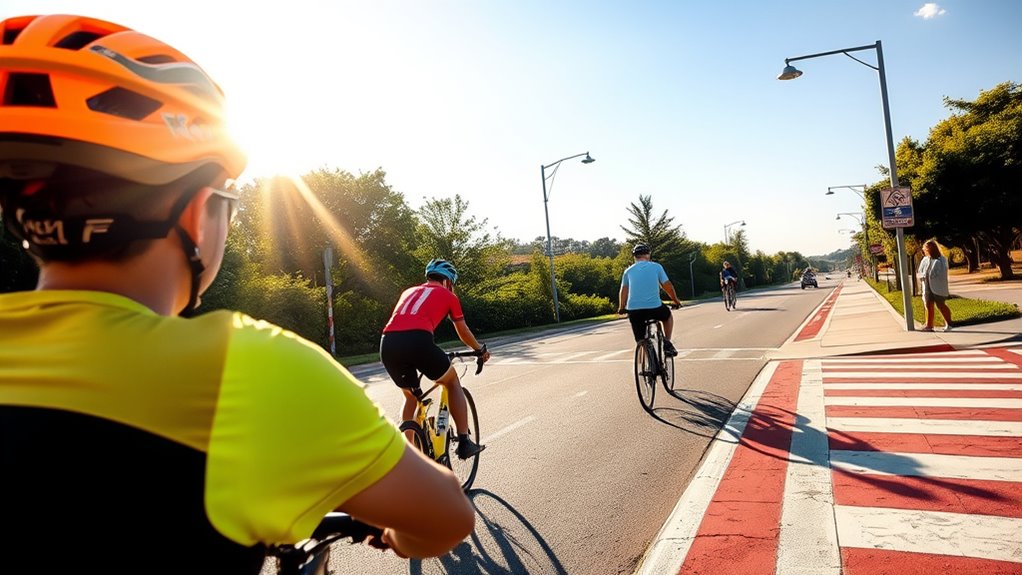
To stay safe while cycling, you need to prioritize visibility and predictability.
Wearing bright colors and using lights will help others see you, especially in low-light conditions.
Plus, following traffic rules and signaling your intentions keeps you and those around you safe on the road.
Visibility and Predictability
Visibility and predictability are essential for your safety as a cyclist. To guarantee you’re seen and your movements are understood, consider these tips:
- Wear brightly colored or reflective clothing, especially in low-light conditions.
- Equip your bike with front and rear lights, as well as reflectors for nighttime rides.
- Use hand signals to clearly indicate your turns and stops.
- Maintain predictable movements by riding in a straight line and avoiding sudden changes.
- Adhere to traffic regulations to foster respect and safety on the road.
Traffic Rules Compliance
Riding safely means not only being visible but also following traffic rules just like any motorist. Cyclists must comply with regulations, including obeying stop signs and traffic signals. Always ride on the right side of the road, and signal your turns and lane changes clearly. This enhances safety for you and others, particularly at intersections where the risk of collisions is high. Stay vigilant and aware of your surroundings, especially when approaching intersections.
| Traffic Rule | Importance |
|---|---|
| Obey Stop Signs | Prevents accidents |
| Signal Turns | Improves communication |
| Ride with Traffic Flow | Enhances safety for all users |
Navigating Shared-use Paths

When you’re on shared-use paths, it’s essential to keep to the right side to let faster users pass safely on the left.
Remember, pedestrians have the right of way, so always be courteous and give them plenty of space.
Here are some important tips to keep in mind:
- Use audible signals, like “on your left,” when approaching others.
- Maintain at least 3 feet of distance when passing pedestrians.
- Slow down and prepare to stop if necessary.
- In crowded areas, ride single file to avoid blocking the path.
- Stay aware of your surroundings to guarantee everyone’s safety.
Passing Protocol and Courtesy
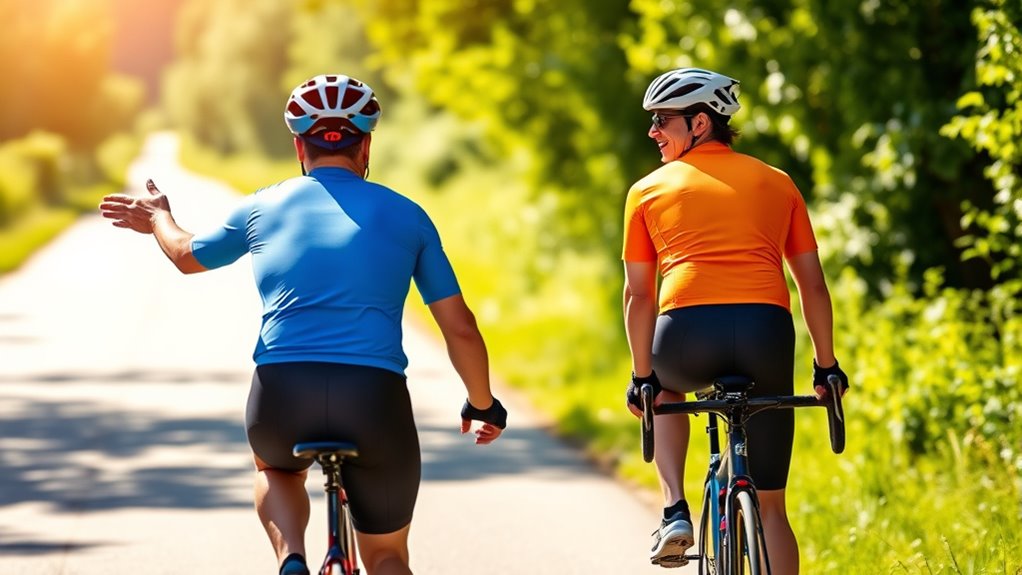
Maneuvering shared-use paths requires awareness not just of your surroundings but also of how to interact with others while cycling.
When you’re approaching another cyclist or pedestrian, always announce your presence with a clear signal, like “on your left.” This simple act helps prevent startling them.
Maintain a safe distance of at least three feet when passing pedestrians to guarantee their comfort and safety. Use hand signals to indicate your intentions, making your movements predictable.
If you’re approaching a group, slow down and give ample space, as they may shift unexpectedly. Always yield to pedestrians, respecting their right of way while you navigate these shared paths.
Following this passing protocol promotes courtesy and safety for everyone involved.
Night Riding Safety Tips

As night falls, ensuring your safety while cycling becomes essential. Here are some vital night riding safety tips to keep you visible and secure:
- Equip your bike with a white front light and a red rear reflector to enhance visibility.
- Aim your bike lights downward to illuminate your path without blinding others.
- Use solid lights instead of flashing ones to avoid disorientation.
- Maintain a safe distance from cyclists and pedestrians; visibility is reduced at night.
- Wear brightly colored or reflective clothing to increase your visibility to motorists.
Visibility and Predictability on the Road
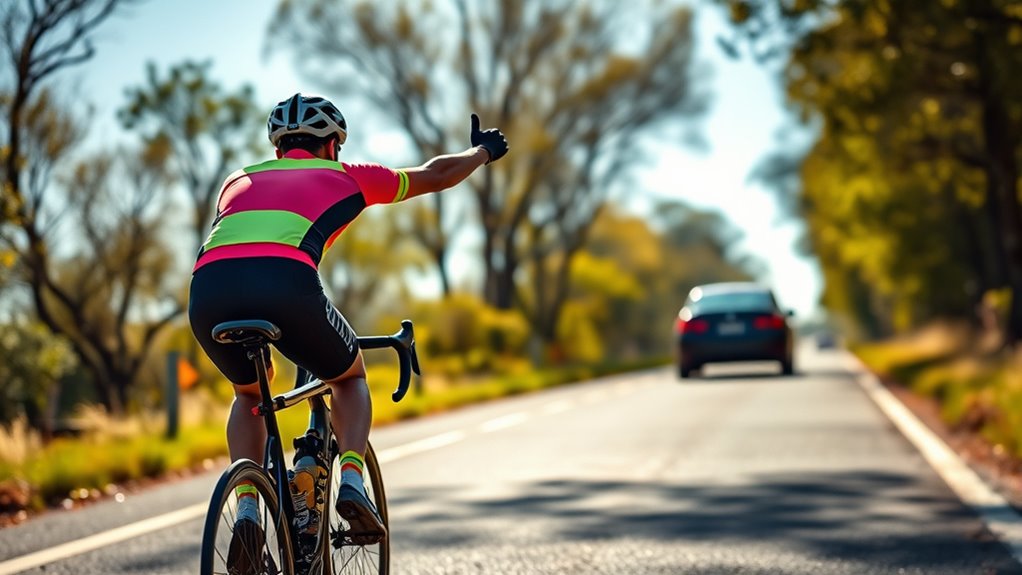
To stay safe on the road, you need to prioritize both visibility and predictability. Wearing brightly colored or reflective clothing makes you more visible to motorists, especially in low light or poor weather. Equip your bike with front and rear lights and reflectors, as this isn’t just a safety measure but often a legal requirement for nighttime riding.
To enhance predictability, use clear hand signals to indicate your turns and stops. Maintain a consistent line and avoid sudden maneuvers; this helps other road users gauge your intentions, reducing accident risks.
Respecting Other Road Users
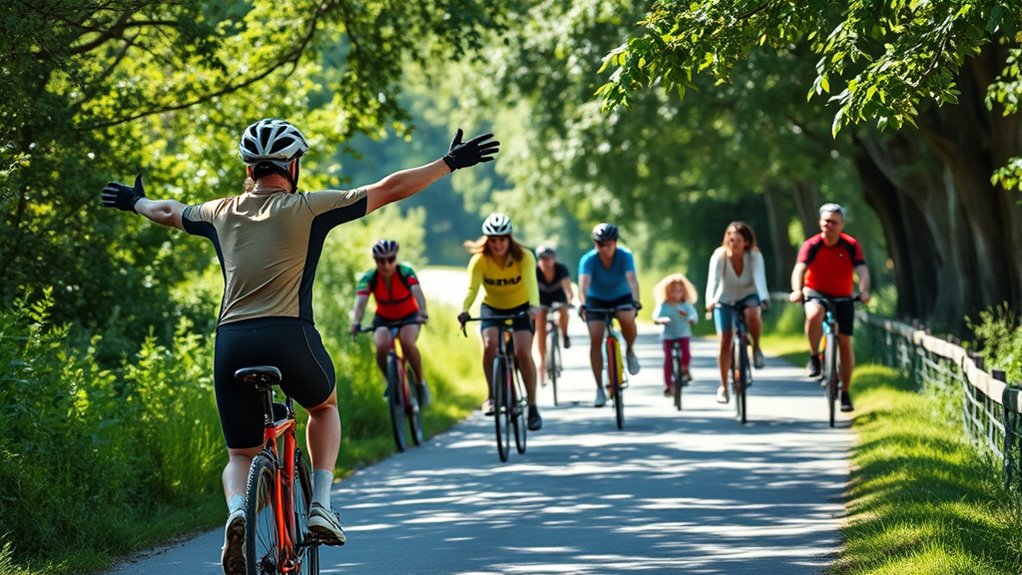
Cycling isn’t just about your own safety; it’s also about being mindful of everyone else on the road. By respecting other road users, you contribute to a harmonious environment for all.
Here are some essential points to remember:
- Always yield to pedestrians on shared paths.
- Maintain at least 3 feet when passing pedestrians.
- Use a friendly “on your left!” to alert them.
- Respect personal space for non-cyclists, like dogs and horses.
- Acknowledge yielding motorists with a wave of thanks.
Frequently Asked Questions
What Are 10 Rules of the Road for Cycling?
When you’re cycling, it’s essential to follow certain rules to guarantee your safety and that of others.
Always obey traffic signals and stop signs. Use hand signals to communicate your intentions clearly. Maintain a straight line and avoid weaving through traffic. Keep a safe distance from parked cars to prevent dooring accidents.
If you’re riding with others, announce your moves and watch for obstacles. Staying predictable makes the road safer for everyone.
What Is the Rule 37 for Cycling?
Ever tried to navigate a busy sidewalk where everyone’s in their own world?
Rule 37 for cycling reminds you to yield to pedestrians. It’s all about keeping a safe distance—at least 3 feet—so you don’t startle anyone.
When you approach, a friendly “on your left” goes a long way. Remember, slowing down in crowded areas isn’t just polite; it’s essential for everyone’s safety and enjoyment on shared paths.
What Is the 75 Rule in Cycling?
The 75 Rule in cycling means you should keep a safe distance of at least 75 centimeters from other cyclists or road users.
This space helps prevent collisions and keeps your ride safe.
When you’re in a group, maintaining this distance is essential to avoid overlapping wheels and crashes.
What Is the Etiquette for Cycling?
Cycling etiquette is all about safety and respect on the road or trail. You should follow traffic rules, signal your turns, and communicate clearly with hand signals.
When riding with others, keep a straight line and avoid overlapping wheels to reduce accidents. If you’re on a shared path, yield to pedestrians and announce your presence.
Wearing bright colors and using lights will help you stay visible, especially in low-light situations.
Conclusion
To summarize, practicing good cycling etiquette not only enhances your experience but also guarantees the safety of everyone on the road. Did you know that cyclists who follow proper passing protocols reduce accident risks by up to 50%? By being courteous and aware, you can make your rides more enjoyable while fostering a friendly environment for all road users. So, whether you’re riding solo or in a group, remember that respect and communication go a long way!
